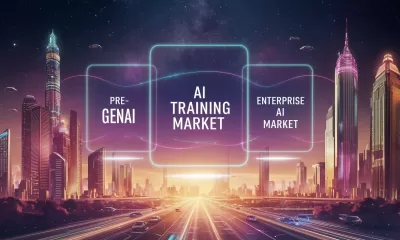News
How Singtel Used AI to Bring Generations Together for Singapore’s SG60
How Singtel’s AI-powered campaign celebrated Singapore’s 60th anniversary through advanced storytelling.
Published
3 months agoon
By
AIinAsia
TL;DR – Quick Summary:
- Singtel’s AI-powered “Project NarrAItive” celebrates Singapore’s SG60.
- Narrates the “Legend of Pulau Ubin” in seven languages using advanced AI.
- Bridges generational and linguistic divides.
- Enhances emotional connections and preserves cultural heritage.
In celebration of Singapore’s 60th anniversary (SG60), Singtel unveiled “Project NarrAItive,” an innovative AI-driven campaign designed to bridge linguistic gaps and strengthen familial bonds. At the core of this initiative was the retelling of the “Legend of Pulau Ubin,” an underrepresented folktale, beautifully narrated in seven languages.
AI Bridging Linguistic Divides
Created in partnership with Hogarth Worldwide and Ngee Ann Polytechnic’s School of Film & Media Studies, Project NarrAItive allowed participants to narrate the folktale fluently in their native languages—English, Chinese, Malay, Tamil, Teochew, Hokkien, and Malayalam. AI technology effectively translated and adapted these narrations, preserving each narrator’s unique vocal characteristics, emotional nuances, and cultural authenticity.
Behind the AI Technology
The project incorporated multiple AI technologies:
- Voice Generation and Translation: Accurately cloned participants’ voices, translating them authentically across languages.
- Lip-syncing: Generated precise facial movements matched perfectly with the translated audio.
- Generative Art: AI-created visuals and animations enriched the storytelling experience, making the narrative visually engaging and culturally resonant.
Cultural and Emotional Impact
The campaign profoundly impacted families by enabling them to see loved ones communicate seamlessly in new languages. According to Lynette Poh, Singtel’s Head of Marketing and Communications, viewers were deeply moved—often to tears—by this unprecedented linguistic and emotional connection (according to Marketing Interactive).
Challenges and Innovations
Executing Project NarrAItive faced significant challenges, including:
- Multilingual Complexity: Ensuring accurate language translations while preserving natural tone and emotion.
- Visual Realism: Creating culturally authentic visuals using generative AI.
- Technical Integration: Seamlessly combining voice, visuals, and animations.
- Stakeholder Coordination: Effectively aligning production teams, educational institutions, and family participants.
AI and the Future of Cultural Preservation
“Project NarrAItive” illustrates the broader potential of AI technology in cultural preservation throughout Asia. By enabling stories to transcend linguistic barriers, AI offers a meaningful pathway for safeguarding heritage and deepening cross-generational connections.
As Singtel’s initiative proves, the thoughtful application of AI can empower communities, preserve invaluable cultural traditions, and foster stronger, more meaningful human connections across generations.
What do YOU think?
Could AI-driven cultural storytelling become a cornerstone of cultural preservation across Asia?
Don’t forget to subscribe to keep up to date with the latest AI news, tips and tricks in Asia and beyond by subscribing to our free newsletter.
You may also like:
- Can Singtel’s Free Access to Perplexity Pro Redefine AI Search?
- The AI Revolution in Asia: Singapore Leads the Way
- Artificial Intelligence and the Quest for AGI in Asia
Author
Discover more from AIinASIA
Subscribe to get the latest posts sent to your email.
You may like
-


The Three AI Markets Shaping Asia’s Future
-


Adobe Jumps into AI Video: Exploring Firefly’s New Video Generator
-


New York Times Encourages Staff to Use AI for Headlines and Summaries
-


Voice From the Grave: Netflix’s AI Clone of Murdered Influencer Sparks Outrage
-


How Will AI Skills Impact Your Career and Salary in 2025?
-


Beginner’s Guide to Using Sora AI Video
News
Apple Intelligence 2025: New AI Leap Changes Everything
Apple’s new AI tools, released at Apple Intelligence 2025, are transforming iPhones across Asia. From live translation to Genmoji, here’s what it means for Asia.
Published
9 minutes agoon
June 10, 2025By
AIinAsia
Picture this: you’re stuck in a Tokyo taxi, desperately trying to explain to the driver where you need to go. Or maybe you’re drowning in a sea of WhatsApp messages from your project team in Singapore, wishing someone could just tell you what the hell happened while you were asleep. Sound familiar?
Well, Apple just dropped something that might actually solve these everyday headaches. Their new “Apple Intelligence” isn’t just another flashy tech announcement—it’s genuinely changing how we use our phones, especially here in Asia where language barriers and information overload are part of daily life.
🔍 TL;DR (Because We Know You’re Busy)
- Apple’s built AI directly into iOS 26, iPadOS 26, and macOS Tahoe—it’s not an app, it’s everywhere
- You get real-time translation, custom emoji creation (they call them “Genmoji”), smart email summaries, and notifications that actually make sense
- Everything happens on your phone first—no creepy cloud surveillance
- Yes, ChatGPT is coming too, but you can turn it off if you want
- Bad news: you need an iPhone 15 Pro or newer (ouch, right?)
- This is Apple’s biggest swing at Google and Samsung’s AI dominance
- Asia’s getting priority treatment for once—expect fast rollouts in Singapore, Japan, Korea, and India
What Apple Intelligence Actually Does (And Why You Should Care)
Forget everything you think you know about AI on phones. Apple isn’t giving you another chatbot to open when you remember to use it. Instead, they’ve woven AI into the actual operating system—so it’s there when you need it, invisible when you don’t.
It’s like having a really smart assistant who knows exactly what you’re trying to do, without you having to explain yourself every single time.
Here’s what you can actually do right now:
- Jump on a FaceTime call with your Japanese colleague and have everything translated in real-time
- Turn those endless group chat threads into a one-sentence summary
- Create custom emojis that actually look like your grumpy boss or your overexcited dog
- Take a screenshot of an event poster and watch it automatically create a calendar invite
- Ask your phone to do stuff using normal human language instead of memorizing specific commands
The best part? Developers can tap into Apple’s AI foundation, so your favorite apps are about to get a lot smarter too.
Privacy: Apple’s Secret Weapon (That Actually Matters)
While Google and Samsung are busy hoovering up your data and sending it to their cloud servers, Apple’s taking a different approach. Most of the AI magic happens right on your device—which means faster responses and no one else getting a peek at your personal stuff.
When your phone does need extra computing power, Apple uses their own “Private Cloud Compute” system that promises to delete everything immediately and never store your data. They’re even letting outside researchers audit the code to prove they’re not lying about it.
Giving our users a personal intelligence system that is easy to use—all while protecting their privacy.
Honestly? In a world where every app seems to want access to your entire digital life, this actually feels refreshing.
The AI Smartphone Battle: Who’s Really Winning?
Let’s be real about where everyone stands:
Apple Intelligence plays it safe but smart, everything integrated seamlessly across your Apple devices, privacy-first approach, but limited to newer hardware.
Google Gemini brings the heavy artillery, incredibly powerful AI capabilities, works across Android devices, but your data’s living in Google’s cloud whether you like it or not.
Samsung Galaxy AI tries to split the difference, some on-device processing, some cloud power, good features, but only if you’re deep in the Samsung ecosystem.
Here’s the thing: Apple now has to convince Asia’s Android power users that privacy and a native experience matter more than raw AI horsepower. That’s a tough sell in markets where people are used to getting the most bang for their buck.
Why This Matters More in Asia
Living in Asia means dealing with unique challenges that Apple Intelligence seems designed to solve:
In Tokyo: That business traveler we mentioned earlier? They can now have actual conversations with taxi drivers, restaurant staff, and shop owners without awkward pointing and Google Translate delays.
In Singapore: Students and office workers dealing with multilingual group chats (you know, the ones where someone’s typing in English, someone else in Mandarin, and your colleague insists on using Singlish) can finally get coherent summaries.
In Bangkok: Small business owners can create product mockups and marketing visuals without paying for expensive design software or hiring freelancers.
The features feel built for our region’s multilingual, always-connected lifestyle in a way that previous AI tools didn’t quite nail.
The Good, The Bad, and The “Maybe Later”
What Works:
- Privacy-focused approach appeals to security-conscious markets like Singapore and Korea
- Offline functionality is perfect for areas with spotty internet (looking at you, rural Indonesia)
- Early language support for English, Japanese, Korean, and Mandarin
- If you own multiple Apple devices, everything just works together seamlessly
What Doesn’t:
- You need an iPhone 15 Pro or newer—that’s a serious investment
- Feature rollouts are staggered across Asia (China’s facing delays due to regulations)
- The creative AI tools are still playing catch-up to what Google can do
What Should You Do Right Now?
First, check if your device can even run this stuff. Only newer Apple devices support Apple Intelligence, and the full compatibility list changes regularly.
If you qualify, here’s what to try first:
- Go to Settings > Apple Intelligence and turn on the features that sound useful
- Test live translation during your next international WhatsApp call
- Take a screenshot of your next meeting invite or event poster and watch the magic happen
- Play around with creating custom emojis (trust us, it’s oddly addictive)
Keep an eye on local rollouts—different countries are getting features at different times, so what works in Singapore might not be available in Manila yet.
Your Questions, Answered
- Do I need a separate ChatGPT account? Nope. Apple’s integrated it directly, but it’s completely optional. Don’t want it? Don’t turn it on.
- What about China? Most features are delayed while Apple works with local regulators and approved partners. Classic China tech rollout situation.
- Isn’t Google Gemini more powerful? In some ways, yes—especially for generating text and images. But Apple’s betting that seamless, private, everyday intelligence beats raw power for most people.
Apple’s Big Asian Gambit
This isn’t just about competing with Google and Samsung globally—Apple’s specifically targeting Asia’s massive smartphone market. With high smartphone adoption, multilingual populations, and tech-savvy young people, our region represents huge growth potential.
But competition is fierce. Samsung dominates in Korea, Google’s gaining ground in India, and China’s regulatory environment remains tricky. Apple can’t afford to mess this up.
Expect to see aggressive localization efforts and marketing campaigns throughout 2025. They’re clearly betting big on winning over Asian consumers who’ve traditionally favored Android devices.
The Bottom Line
Apple Intelligence isn’t perfect, and it’s definitely not revolutionary in the way the original iPhone was. But it might be something more valuable: actually useful AI that doesn’t feel like a gimmick or a privacy nightmare.
For those of us living in Asia’s multilingual, fast-paced environment, these features address real daily frustrations. The question isn’t whether AI is coming to smartphones—it’s already here. The question is whether you trust Apple’s approach over the alternatives.
So here’s what we’re curious about: will you let Apple’s AI summarize your chaotic group chats, translate your international calls, and generate those weirdly specific custom emojis you never knew you needed?
Drop us a comment below and let us know what you think. And if you want more Asia-focused tech analysis that actually makes sense, subscribe to AIinASIA—we promise to keep cutting through the hype.
You may also like:
- Will Apple’s ChatGPT Partnership Revolutionise AI?
- Apple and Meta Explore AI Partnership
- Or read more at Apple’s official website by tapping here.
Author
Discover more from AIinASIA
Subscribe to get the latest posts sent to your email.
News
If AI Kills the Open Web, What’s Next?
Exploring how AI is transforming the open web, the rise of agentic AI, and emerging monetisation models like microtransactions and stablecoins.
Published
2 weeks agoon
May 28, 2025By
AIinAsia
The web is shifting from human-readable pages to machine-mediated experiences with AI impacting the future of the open web. What comes next may be less open—but potentially more useful.
TL;DR — What You Need To Know
- AI is reshaping web navigation: Google’s AI Overviews and similar tools provide direct answers, reducing the need to visit individual websites.
- Agentic AI is on the rise: Autonomous AI agents are beginning to perform tasks like browsing, shopping, and content creation on behalf of users.
- Monetisation models are evolving: Traditional ad-based revenue is declining, with microtransactions and stablecoins emerging as alternative monetisation methods.
- The open web faces challenges: The shift towards AI-driven interactions threatens the traditional open web model, raising concerns about content diversity and accessibility.
The Rise of Agentic AI
The traditional web, characterised by human users navigating through hyperlinks and search results, is undergoing a transformation. AI-driven tools like Google’s AI Overviews now provide synthesised answers directly on the search page, reducing the need for users to click through to individual websites.
This shift is further amplified by the emergence of agentic AI—autonomous agents capable of performing tasks such as browsing, shopping, and content creation without direct human intervention. For instance, Opera’s new AI browser, Opera Neon, can automate internet tasks using contextual awareness and AI agents.
These developments suggest a future where AI agents act as intermediaries between users and the web, fundamentally altering how information is accessed and consumed.
Monetisation in the AI Era
The traditional ad-based revenue model that supported much of the open web is under threat. As AI tools provide direct answers, traffic to individual websites declines, impacting advertising revenues.
In response, new monetisation strategies are emerging. Microtransactions facilitated by stablecoins offer a way for users to pay small amounts for content or services, enabling creators to earn revenue directly from consumers. Platforms like AiTube are integrating blockchain-based payments, allowing creators to receive earnings through stablecoins across multiple protocols.
This model not only provides a potential revenue stream for content creators but also aligns with the agentic web’s emphasis on seamless, automated interactions.
The Future of the Open Web
The open web, once a bastion of free and diverse information, is facing significant challenges. The rise of AI-driven tools and platforms threatens to centralise information access, potentially reducing the diversity of content and perspectives available to users.
However, efforts are underway to preserve the open web’s principles. Initiatives like Microsoft’s NLWeb aim to create open standards that allow AI agents to access and interact with web content in a way that maintains openness and interoperability.
The future of the web may depend on balancing the efficiency and convenience of AI-driven tools with the need to maintain a diverse and accessible information ecosystem.
What Do YOU Think?
As AI impacts the future of the open web, we must consider how to preserve the values of openness, diversity, and accessibility. How can we ensure that the web remains a space for all voices, even as AI agents become the primary means of navigation and interaction?
You may also like:
- Top 10 AI Trends Transforming Asia by 2025
- Build Your Own Agentic AI — No Coding Required
- Is AI Really Paying Off? CFOs Say ‘Not Yet’
- Or tap here to explore the free version of Claude AI.
Author
Discover more from AIinASIA
Subscribe to get the latest posts sent to your email.
News
GPT-5 Is Less About Revolution, More About Refinement
This article explores OpenAI’s development of GPT-5, focusing on improving user experience by unifying AI tools and reducing the need for manual model switching. It includes insights from VP of Research Jerry Tworek on token growth, benchmarks, and the evolving role of humans in the AI era.
Published
3 weeks agoon
May 22, 2025By
AIinAsia
OpenAI’s next model isn’t chasing headlines—it’s building a smoother, smarter user experience with fewer interruptions the launch of GPT-5 unified tools.
TL;DR — What You Need To Know
- GPT-5 aims to unify OpenAI’s tools, reducing the need for switching between models
- The Operator screen agent is due for an upgrade, with a push towards becoming a desktop-level assistant
- Token usage continues to rise, suggesting growing AI utility and infrastructure demand
- Benchmarks are losing their relevance, with real-world use cases taking centre stage
- OpenAI believes AI won’t replace humans but may reshape human labour roles
A more cohesive AI experience, not a leap forward
While GPT-4 dazzled with its capabilities, GPT-5 appears to be a quieter force, according to OpenAI’s VP of Research, Jerry Tworek. Speaking during a recent Reddit Q&A with the Codex team, Tworek described the new model as a unifier—not a disruptor.
“We just want to make everything our models can currently do better and with less model switching,” Tworek said. That means streamlining the experience so users aren’t constantly toggling between tools like Codex, Operator, Deep Research and memory functions.
For OpenAI, the future lies in integration over invention. Instead of introducing radically new features, GPT-5 focuses on making the existing stack work together more fluidly. This approach marks a clear departure from the hype-heavy rollouts often associated with new model versions.
Operator: from browser control to desktop companion
One of the most interesting pieces in this puzzle is Operator, OpenAI’s still-experimental screen agent. Currently capable of basic browser navigation, it’s more novelty than necessity. But that may soon change.
An update to Operator is expected “soon,” with Tworek hinting it could evolve into a “very useful tool.” The goal? A kind of AI assistant that handles your screen like a power user, automating online tasks without constantly needing user prompts.
The update is part of a broader push to make AI tools feel like one system, rather than a toolkit you have to learn to assemble. That shift could make screen agents like Operator truly indispensable—especially in Asia, where mobile-first behaviour and app fragmentation often define the user journey.
Integration efforts hit reality checks
Originally, OpenAI promised that GPT-5 would merge the GPT and “o” model series into a single omnipotent system. But as with many grand plans in AI, the reality was less elegant.
In April, CEO Sam Altman admitted the challenge: full integration proved more complex than expected. Instead, the company released o3 and o4-mini as standalone models, tailored for reasoning.
Tworek confirmed that the vision of reduced model switching is still alive—but not at the cost of model performance. Users will still see multiple models under the hood; they just might not have to choose between them manually.
Tokens and the long road ahead
If you think the token boom is a temporary blip, think again. Tworek addressed a user scenario where AI assistants might one day process 100 tokens per second continuously, reading sensors, analysing messages, and more.
That, he says, is entirely plausible. “Even if models stopped improving,” Tworek noted, “they could still deliver a lot of value just by scaling up.”
This perspective reflects a strategic bet on infrastructure. OpenAI isn’t just building smarter models; it’s betting on broader usage. Token usage becomes a proxy for economic value—and infrastructure expansion the necessary backbone.
Goodbye benchmarks, hello real work
When asked to compare GPT with rivals like Claude or Gemini, Tworek took a deliberately contrarian stance. Benchmarks, he suggested, are increasingly irrelevant.
“They don’t reflect how people actually use these systems,” he explained, noting that many scores are skewed by targeted fine-tuning.
Instead, OpenAI is doubling down on real-world tasks as the truest test of model performance. The company’s ambition? To eliminate model choice altogether. “Our goal is to resolve this decision paralysis by making the best one.”
The human at the helm
Despite AI’s growing power, Tworek offered a thoughtful reminder: some jobs will always need humans. While roles will evolve, the need for oversight won’t go away.
“In my view, there will always be work only for humans to do,” he said. The “last job,” he suggested, might be supervising the machines themselves—a vision less dystopian, more quietly optimistic.
For Asia’s fast-modernising economies, that might be a signal to double down on education, critical thinking, and human-centred design. The jobs of tomorrow may be less about doing, and more about directing.
You May Also Like:
- ChatGPT-5 Is Coming in 2024: Sam Altman
- Revolutionise Your Designs with Canva’s AI-Powered Magic Tools
- Revolutionising Critical Infrastructure: How AI is Becoming More Reliable and Transparent
- Or tap here to try the free version of ChatGPT.
Author
Discover more from AIinASIA
Subscribe to get the latest posts sent to your email.

Apple Intelligence 2025: New AI Leap Changes Everything

The Dirty Secret Behind Your Favourite AI Tools

How To Teach ChatGPT Your Writing Style
Trending
-

 Learning3 weeks ago
Learning3 weeks agoHow to Use the “Create an Action” Feature in Custom GPTs
-

 Learning3 weeks ago
Learning3 weeks agoHow to Upload Knowledge into Your Custom GPT
-

 Learning2 weeks ago
Learning2 weeks agoBuild Your Own Custom GPT in Under 30 Minutes – Step-by-Step Beginner’s Guide
-

 News9 minutes ago
News9 minutes agoApple Intelligence 2025: New AI Leap Changes Everything
-

 Life6 days ago
Life6 days agoHow To Teach ChatGPT Your Writing Style
-

 Life5 days ago
Life5 days agoThe Dirty Secret Behind Your Favourite AI Tools
-

 Business3 weeks ago
Business3 weeks agoAdrian’s Arena: Stop Collecting AI Tools and Start Building a Stack
-

 News3 weeks ago
News3 weeks agoAI still can’t tell the time, and it’s a bigger problem than it sounds































